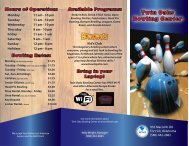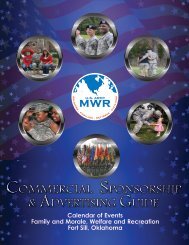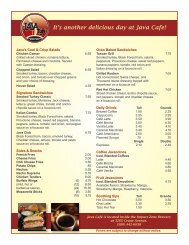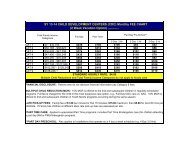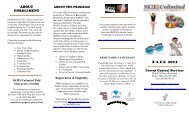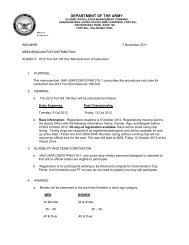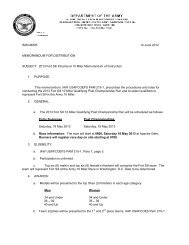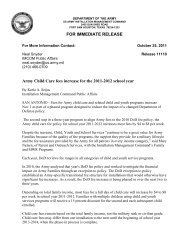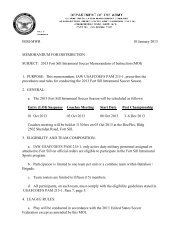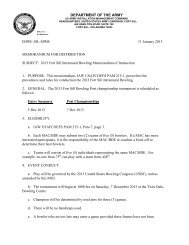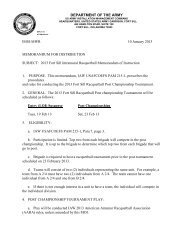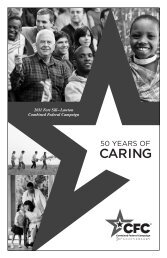Preparing and Managing Correspondence - Fort Sill MWR
Preparing and Managing Correspondence - Fort Sill MWR
Preparing and Managing Correspondence - Fort Sill MWR
Create successful ePaper yourself
Turn your PDF publications into a flip-book with our unique Google optimized e-Paper software.
number to indicate whether it is the first, second, or other copy (for example, Encl 1 1 , Encl 1 2 ). Identify enclosures to<br />
enclosures as “Encl 1 to Encl 1,” “Encl 2 to Encl 1,” <strong>and</strong> so forth.<br />
(3) When an enclosure is sent separately from the correspondence, write it in the body of the correspondence <strong>and</strong><br />
add a short note to the enclosure when forwarded. Add fwd sep (forwarded separately) behind the identification of the<br />
appropriate enclosure:<br />
Encl<br />
Station List fwd sep<br />
4–3. Tabbing enclosures<br />
If correspondence has many enclosures, tab each one. This helps the reader easily find enclosures. (See fig 4–1.)<br />
Unless legal procedures dictate otherwise, use paper, cloth, or clear plastic index tabs. Put the tabs on the right-h<strong>and</strong><br />
side of blank sheets of paper (above the identified enclosure or attachment). Position the first tab 1 ⁄4 to 1 ⁄2 inch from the<br />
top of the page. Space subsequent tabs approximately 1 ⁄4 inch apart. This ensures that all tabs are visible <strong>and</strong> evenly<br />
spaced. If an enclosure has its own enclosures that need tabbing, use a different color or type of tab to identify these<br />
secondary documents. Avoid tabbing these secondary documents unless the specific information located there was<br />
mentioned in the text of the correspondence.<br />
4–4. Tabbing correspondence packages<br />
a. The following guidance is provided to assist in tabbing a correspondence package forwarded for signature or<br />
approval. Identify the tabs in the document. Tabs may be any letter or number as long as they are consecutive <strong>and</strong> are<br />
fully identified in the text.<br />
(1) First tab—correspondence to be signed or material to be approved.<br />
(2) Second tab—document that started the action (that is, the incoming correspondence, message, or tasking<br />
documents).<br />
(3) Subsequent tabs—backup information <strong>and</strong> staff coordination comments.<br />
b. Position tabs on separate blank sheets of paper as specified in paragraph 4–3.<br />
c. Local procedures will dictate any specific requirement regarding the type or color of tabs.<br />
4–5. Assembling<br />
a. Assemble correspondence as shown in figure 4–2<br />
b. Documents that are placed on the long axis of the page (l<strong>and</strong>scape mode) will be assembled in a correspondence<br />
package so that the long side is to the left; that is, the top of the page will be on the side that would be bound if the<br />
package were a book.<br />
38 AR 25–50 • 3 June 2002



